Dicksonia antarctica



Leaf scars or bases
Persistent leaf bases attached to the trunk or leaf scars that remain on the trunk.
Standard
A plant with a free standing erect stem and terminal foliage.This tree-fern forms a massive buttress trunk (caudex) up to 2 m (6 ft) in diameter and covered in brown hairs and fibrous roots. It has large soft textured divided dark green fronds radiate out from the crown and the fertile fronds appear in summer.
Dicksonia antarctica Labill. is naturally found on the east coast from Queensland to New South Wales, Victoria, South Australia and Tasmania in Australia. It grows in high rainfall areas in moist lowland gullies or in cloud forests on the mountains, appearing from sea level to and elevation of 4,400 m (14,436 ft). It prefers a well drained deep reliably moist peaty-sandy loam that is slightly acidic, with a pH range from 5.0 to 7.5. It grows in a semi-shaded to shaded wind protected humid position and is cold, light frost and moderately drought tolerant with a preferred minimum winter temperature of 15ºC (60ºF) but will tolerate -6ºC (21ºF) for short periods.
The Soft Tree Fern is grown for its soft leafy appearance and is planted in the understory of shaded garden borders or mass planted in damp gullies for a rainforest effect. It is also used around water features or grown as a container plant. It is slow growing and normally bought at its established height, and can be easily transplanted for an instant effect in a new garden. Once established it has a medium water requirement, (Scale: 2-drops from 3) and responds to mulching and misting to increase humidity.
I.D. 435
UK hardiness zone H3
Climate zones 8, 9, 14 - 17, 19 - 24
USDA Zone 8-10
Dicksonia (dik-SON-ee-a) antarctica (an-TARK-ti-ka)
Etymology
Genus: - Dicksonia named after James Dickson, 1738-1822, who was Scottish nurseryman / botanist
Species: Latin - antarctica – meaning (southern) referring to the Antarctic regions

Australia, (Queensland, New South Wales, Victoria, South Australia, Tasmania)
Cyatheaceae (sy-AY-thee-AY-see-ee)
The plants in this family are tree or terrestrial ferns that form trunks; sub erect creeping stems or is prostrate.
Distribution
These plants are found from tropical rainforests to cool temperate zones with high rainfall.
Diagnostic Features
The fronds are arranged spirally on the trunk with the base of the stipes remaining or leaving oval scars, pinnate shape and having hairs or scales on the pinna-rhachis and the costae is raised or grooved. The pinnules are normally symmetrical and the fertile and sterile segments are simular to dimorphic.
Stomata have one to three subsidiary cells and the round sori are superficial or marginal. The indusium is at the end of the veins and is protected by a marginal lobe of the lamina this is the outer indusium, the inner is thinner and on the surface of the veins.
The indusium is cup-shaped (hemitelioid) is two lipped and globular.
The receptacle may be knob-like and erect or columnar or just slightly raised. The sporangia are even around the receptacle and the annulus is composed of fourteen to twenty eight cells, which are not interrupted by the pedicel.
Note:
The plants in this family are used in domestic gardens or in wet gully planting.
This plant tolerates between USDA zones 8a to 10a and grows to 15 m (50 ft)
Fahrenheit 10º to 35º F
These temperatures represent the lowest average.
Celsius -12.2º to -1.6º C
Attention
All photographs and data are covered by copyright. Apart from any fair dealing for the purpose of private study, research, reference or review, as permitted under the Copyright Act, no part may be reproduced by any means with out written permission. All inquiries should be addressed to plantfile.com attention Peter Kirkland.

Compound
The leaf that is divided into separate units (leaflets).
Bipinnate
A compound leaf that secondary leaflets arise along secondary mid ribs.
Rosette
A cluster radiating from a common source.
Serrate
When the leaf margin is sharply indented (like the teeth of a saw).

Sori
A patch of fructification on the back of the fronds of ferns.| Jan | Feb | Mar | Apr | May | Jun |
| Jul | Aug | Sep | Oct | Nov | Dec |
The round sori are marginal and are protected by 2 valve cups on outer side of the reflex margin. The fertile fronds appear during midsummer.

Sporangium
It is a cell or structure where the spores are produced on the undersides of fronds."| Jan | Feb | Mar | Apr | May | Jun |
| Jul | Aug | Sep | Oct | Nov | Dec |
The spores are produced on the underside of the fronds in the sporangium during the sporophyte stage of the fern life cycle. This fern is commonly transplanted and normally sold, according to length of the trunk.
The Soft Tree Fern is grown for its soft leafy appearance and is planted in the understory of shaded garden borders or mass planted in damp gullies for a rainforest effect. It is also used around water features or grown as a container plant. It is slow growing and normally bought at its established height and can be easily transplanted for an instant effect in a new garden.
FERNS
General cultural requirements for ferns
Temperature
The ideal temperature required for ferns ranges from 15.5º to 22º C (60º to 70º F); above and below these temperatures the ferns tend to suffer.
Light
Naturally a fern receive bright dappled light and for successful growth around a home bright indirect light is preferred. Ferns do poorly if grown in the shade.
Water
Ferns require constantly moist, well drained soils but not wet or waterlogged as this promotes rot. Ferns like the water to pass by the roots regularly.
Humidity
Ferns need a humid environment and do poorly in dry air. Humidity may be maintained for potted plants by regular misting of the fronds or by placing the container above a saucer filled with water. In the outdoors maintain moist soils or in hot weather outside spray the area with a garden hose for a short period regularly.
Re-potting
Re-pot ferns when the roots have filled the container, preferable during spring and use a well drained loam based soil mix with added leaf mould. When planting, be careful not to bury the crown of the plant.
When fertilising, ferns prefer a little and regular liquid fertiliser during the growing period and this will improve pale fronds and weak growth.
Soil
Generally ferns prefer a heaver well drained soil type with ample organic matter tending acidic. Sandy soil types require regular mulching and heavy clay soils require the addition of gypsum and organic matter in conduction with cultivation to make it more friable. They will tolerate most soil types including granite or basalt based and some species are found in limestone base soils. All require organic material and moisture.
PEST
NAME
Leaf Hopper (General)
Various Leaf Hopper Species
ORDER
Hemiptera
FAMILY
Eurytomidae
Description of the Pest
Generally hopper grows up to 15mm in length, with "A"-shaped folded wings that give it a characteristic triangular cross-section. The adults often have bright coloured markings and the nymphs conjugate in colonies. Adults can fly but will hop away immediately if disturbed and both nymphs and mature hoppers have piercing and sucking mouth parts.
The Passion Vine Hopper (Scolypopa australis) has clear triangular wings that have brown margins and black bands. The nymphs are wingless and white with tufts of hair on the end of the abdomen.
The Green Leaf Hopper (siphanta acuta) looks triangular with its steeply folded wings and can grow to 10mm long. The adults are generally a solitary feeder but the nymphs congregate on shoots.
Appearance and Distribution of the Pest
The adults and nymphs are present throughout the year in tropical to warm temperate regions and are dispersed by flying.
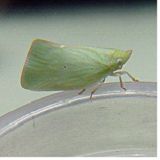
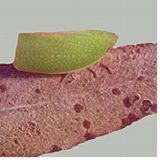
Life Cycle
These insects have a Hemimetabolous life cycle, ie. When the immature nymphs resemble the adults.
Females deposit eggs in slits they make in the bark or on the leaves of the host, and several generations may appear annually on the same plant.
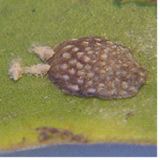 Egg and Nymph
Egg and Nymph
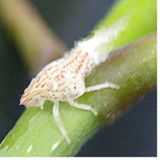
Damage Caused
Nymphs and adults are gregarious, and both stages may be found on host plants at the same time. If large numbers attack young new growth, sucking sap from leaf petioles and young stems, the host plant may become stressed. Severe infestations may weaken and eventually kill the plant with dieback and distorted leaves.
The nymphs exude a sweet secretion, which is attractive to ants that attend and protect the colony. The honeydew also causes sooty mould to occur as a secondary problem. Some species produce toxic saliva that kills the effected plant tissue; other species carry plant viruses.
Susceptible Plants
Most Eucalyptus, Acacia and Casuarina species are attacked by a variety of leafhoppers. Many other Australian native and ornamental plants are attacked.
Acer species are attacked by the leaf hopper (Alebra albostriella) which lays eggs under the bark causing minor swelling. Acer platanoides is particularly venerable.
Callistephus and Aster species are attacked by the Leaf Hopper (Macrosteles fascifrons) that generally causes little harm to the plant but transmits Yellow Disease, a viral infection.
Fern species are attacked by several types of leaf hopper, particularly the Passion Vine Hopper (Scolypopa australis). New fronds become deformed or misshapen as the insect sucks the sap causing dead patches to appear.
Parthenocissus species are attacked by the Green Leaf Hopper.
Rosa species are attacked by the Rose Leaf-hopper (Edwardsiana rosae), nymphs feed on the underside of leaves causing white blotches.
Sorbus aucuparia is attacked by the Japanese Leaf Hopper (Orientus ishidae) which causes the leaves to form a brown blotches with yellowish margins.
Cultural Control
Improving the culture of the host species may assist in maintaining vigorous growth, to minimise shock from infestations. It may be possible to remove them by hand, from young trees, using a small butterfly net if you are lucky.
Biological Control
Controlled by natural predation and the Green Leaf Hopper causes little harm and control is unnecessary.
Chemical Control
Under normal circumstances, it is impractical and unnecessary to treat mature trees however, hoppers on young plants may be treated with a contact insecticide. Note
Always read the label for registration details and direction of use prior to application of any chemicals.
DISEASE
NAME
Sunscald
Environmental (Sun)
Description
Excessive or sudden direct light on the plant combined with high temperatures.
Symptoms
Central parts of the leaf become burnt turning the areas yellow. This area soon becomes brown to black causing the death of the leaf. In climates where it snows unripe wood is damaged by hot spring temperatures in conjunction with Winter Damage. In this case the leaves and stems turn reddish from the excessive cold and when temperatures increase transpiration is inhibited by the frozen soil and poor leaf development, resulting in die back.
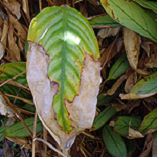 Ctenanthe oppenheimiana
Ctenanthe oppenheimiana
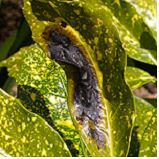 Aucuba japonica
Aucuba japonica
Favoured Conditions
Hot mid day, full sun exposure to plants that normally are protected, or excessive heat waves that cause damage to plants which otherwise tolerate full sun. Plants are most susceptible during spring as the new growth develops.
Affected Plants
All plants can be damaged from Sunscald.
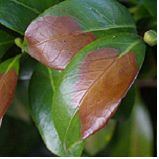 Camellia species
Camellia species
Camellia reticulata and Camellia japonica are sensitive to excessive light turning the leaves brown and Camellia sasanqua is less venerable.
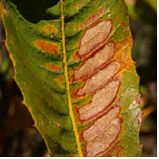 Banksia robur
Banksia robur
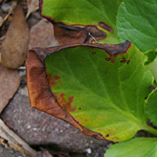 Bergenia x schmidtii
Bergenia x schmidtii
Hoya and Buxus species, Aucuba japonica, Banksia robur and Bergenia x schmidtii are also sensitive to excessive sun.
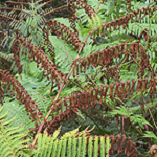 Cyathea australis (Tree Fern)
Cyathea australis (Tree Fern)
Ferns are particularly susceptible to variations in light intensity, combined with high temperatures.
Non-chemical Control
Select plants that tolerate full sun, or protect existing plants from excessive light.
Chemical Control
Not applicable in this case.
Average Lowest Temperature : -5º C 23º F
USDA : 8, 9, 10
This USDA (United States Department of Agriculture) hardiness zone chart can be used to indicate a plant’s ability to withstand average minimum temperatures. However, other factors such as soil type, pH, and moisture, drainage, humidity and exposure to sun and wind will also have a direct effect on your plant’s survival. Use this chart only as a guide, always keep the other factors in mind when deciding where, when and what to plant.
A plant's individual USDA zone can be found in the Plant Overview.
Region of origin
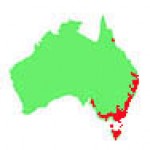
Australia, (Queensland, New South Wales, Victoria, South Australia, Tasmania)
Climate Description
Cool Temperate
This zone has low winter temperatures and moderate summer temperatures with low humidity and cool nights. Frosts are severe with snow at higher altitudes.
Drought rarely occurs and wind is cold inland or wet on the coast.
Plant growth
Cool weather plants grow well.
| Dictionary | Growth Habit |
| Leaf Type | Botanic Flower Description |
| Leaf Shape | Flower Inflorescence |
| Leaf Arrangement | Fruit Type |
| Leaf Margin | Bark Type |
| Leaf Apex And Bases | Flower Description |